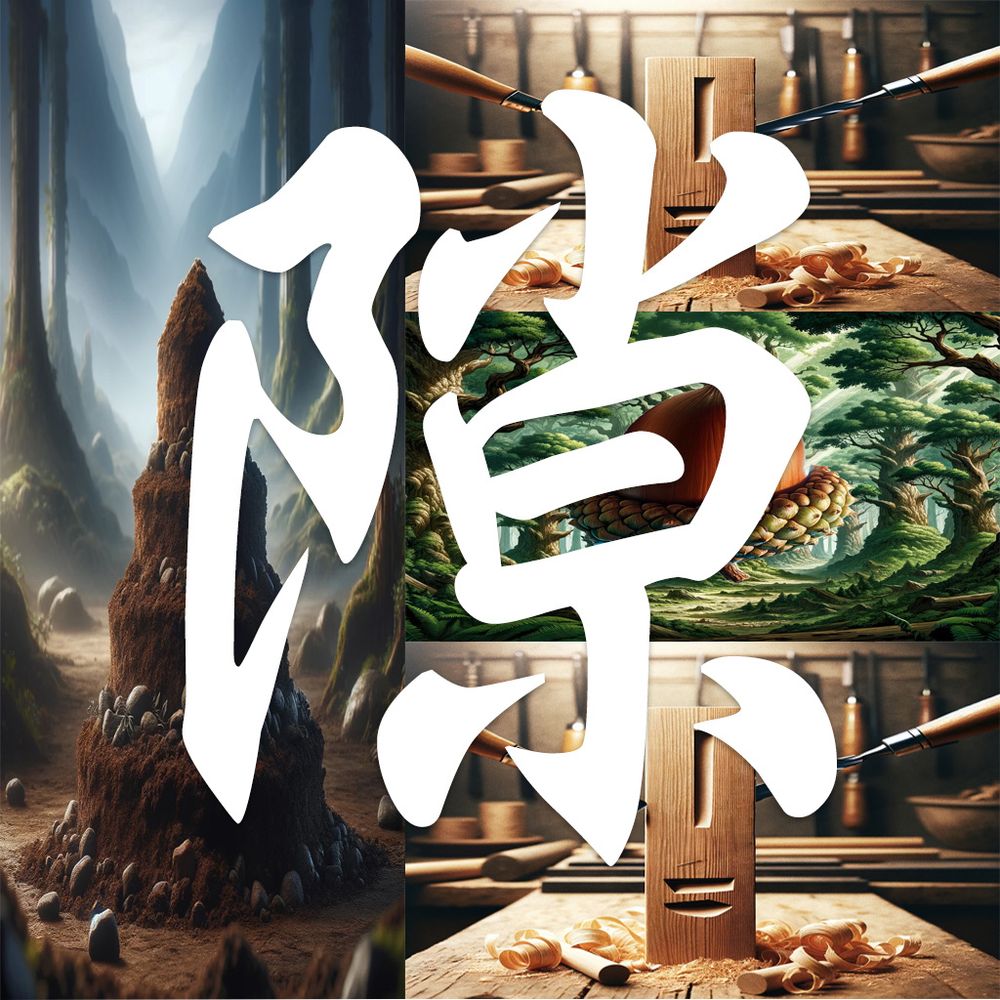
The kanji 比 began life as two figures standing so uncomfortably close you wonder if ancient scribes invented personal space or immediately compared theirs to someone else's and realized they came up short.

The kanji 比 began life as two figures standing so uncomfortably close you wonder if ancient scribes invented personal space or immediately compared theirs to someone else's and realized they came up short.

If terror had a logo, 恐 would be a minimalist masterpiece: neat lines, a hollow center, and the unsettling suggestion that someone has politely but firmly drilled a hole straight through your chest.

If terror had a logo, 恐 would be a minimalist masterpiece: neat lines, a hollow center, and the unsettling suggestion that someone has politely but firmly drilled a hole straight through your chest.
隙 (suki) is the kanji equivalent of that one friend who shows up uninvited and finds the only crack in your plans, your wall, or your emotional defenses. It means "gap," "opening," or "lapse": basically, anything that lets in cold air or crushing defeat.

隙 (suki) is the kanji equivalent of that one friend who shows up uninvited and finds the only crack in your plans, your wall, or your emotional defenses. It means "gap," "opening," or "lapse": basically, anything that lets in cold air or crushing defeat.
Let's talk about 作 (tsukuru): the kanji that practically rolls up its sleeves and gets to work.

Let's talk about 作 (tsukuru): the kanji that practically rolls up its sleeves and gets to work.
一瞬で大金を手に入れるって、夢ありますよね?でも、それって…グレーじゃない?今回の主役は「荒稼ぎ」。漢字を分解していくと、草もない、川も干上がった、豚が屋根の下で眠ってる…?なんじゃそりゃ。でも見終わるころには、あなたも合法的に稼げそうな気がしてくるかも?
www.youtube.com/shorts/P4lis...
#漢字の世界 #言葉の裏側 #日常に潜む哲学 #稼ぐって何 #ワードにツッコミ

Ever wanted to get rich without jail time? Meet 荒稼ぎ (arakasegi): a Japanese word so powerful, it could've been Jordan Belfort's battle cry.
www.youtube.com/shorts/P4lis...

Ever wanted to get rich without jail time? Meet 荒稼ぎ (arakasegi): a Japanese word so powerful, it could've been Jordan Belfort's battle cry.
www.youtube.com/shorts/P4lis...
Today's kanji is 痛. Tsū or itai, meaning pain, sorrow, or just a good old-fashioned "ow." And this one doesn't just mean pain: it looks like it hurts.

Today's kanji is 痛. Tsū or itai, meaning pain, sorrow, or just a good old-fashioned "ow." And this one doesn't just mean pain: it looks like it hurts.
快 (kai) is the kanji equivalent of that feeling when your phone battery jumps from 1% to 80% in five minutes. Relief. Lightness. A breezy "I got this" energy. And all of it, believe it or not, thanks to a tiny radical with slicing ambitions.

快 (kai) is the kanji equivalent of that feeling when your phone battery jumps from 1% to 80% in five minutes. Relief. Lightness. A breezy "I got this" energy. And all of it, believe it or not, thanks to a tiny radical with slicing ambitions.
Say hello to 話 (hanashi or wa), the kanji for speech, conversation, language: or as I like to call it, "when your tongue refuses to shut up." Let's dissect this chatty character. First up: 言, the radical for "to speak."

Say hello to 話 (hanashi or wa), the kanji for speech, conversation, language: or as I like to call it, "when your tongue refuses to shut up." Let's dissect this chatty character. First up: 言, the radical for "to speak."
Meet 耐 (taeru), the kanji that turns "suffering in silence" into a full-body sport. This stoic little square is built from two parts: on top, we have 而, representing soft, drooping hairs: yes, think grandpa's wispy beard on a humid day.

Meet 耐 (taeru), the kanji that turns "suffering in silence" into a full-body sport. This stoic little square is built from two parts: on top, we have 而, representing soft, drooping hairs: yes, think grandpa's wispy beard on a humid day.
Meet 碌 (roku), a kanji that looks like it's been through some stuff, and has the etymology to prove it.

Meet 碌 (roku), a kanji that looks like it's been through some stuff, and has the etymology to prove it.
死 (shi) is the kanji equivalent of the grim reaper tapping you on the shoulder. With a meaning as final as "death" or "to die," it doesn't beat around the bush. But like all good horror stories, it has layers. Structurally, 死 is a visual eulogy.

死 (shi) is the kanji equivalent of the grim reaper tapping you on the shoulder. With a meaning as final as "death" or "to die," it doesn't beat around the bush. But like all good horror stories, it has layers. Structurally, 死 is a visual eulogy.
「指輪(ゆびわ)」の漢字をサクッと分解しつつ、ちょっと毒のある視点で真相に迫ります。
笑えて刺さる、でもどこか考えさせられる。
あなたの“指輪観”がひっくり返るかもしれません。
#指輪の真実 #結婚のリアル #愛か首輪か #漢字の深み #考え直そう
www.youtube.com/shorts/LugCW...

What if your wedding ring isn't a symbol of love... but a luxury collar in disguise?
Dive into the hidden meaning behind "yubiwa," where character breakdown meets sharp-edged humor.
www.youtube.com/shorts/LugCW...

What if your wedding ring isn't a symbol of love... but a luxury collar in disguise?
Dive into the hidden meaning behind "yubiwa," where character breakdown meets sharp-edged humor.
www.youtube.com/shorts/LugCW...
You can't see it. You can't touch it. But it will absolutely ruin your picnic or your personality. Meet 気 (ki): Japan's favorite invisible force, responsible for the weather, your mood, and 70% of polite conversation.

You can't see it. You can't touch it. But it will absolutely ruin your picnic or your personality. Meet 気 (ki): Japan's favorite invisible force, responsible for the weather, your mood, and 70% of polite conversation.
Something big just happened in Japan's creative industry: bigger than most headlines admit. Glovision, one of the country's major dubbing and subtitling studios, was formally warned by the Fair Trade Commission...

Something big just happened in Japan's creative industry: bigger than most headlines admit. Glovision, one of the country's major dubbing and subtitling studios, was formally warned by the Fair Trade Commission...
Meet 秋 (aki): the kanji for "autumn," and arguably the most agriculturally accurate season Japan ever wrote down. It's made of 禾 (grain) and 火 (fire). But no, this isn't a rustic ode to crop-burning. That fiery bit?

Meet 秋 (aki): the kanji for "autumn," and arguably the most agriculturally accurate season Japan ever wrote down. It's made of 禾 (grain) and 火 (fire). But no, this isn't a rustic ode to crop-burning. That fiery bit?
Let's talk 塗料 (toryō). Technically "paint" or "coating," but spiritually? It's personality paste for furniture that's seen things. 塗 is where the mess begins. This kanji throws together water (氵), dirt (土), and a trowel (余). Yes, a trowel.

Let's talk 塗料 (toryō). Technically "paint" or "coating," but spiritually? It's personality paste for furniture that's seen things. 塗 is where the mess begins. This kanji throws together water (氵), dirt (土), and a trowel (余). Yes, a trowel.
擁 (yō) is what happens when a hug grows up, joins the military, and starts a political career. On the left: 手. A hand. So far, so Disney. But on the right? That's 雍 (also yō), and that's where the therapy bills start stacking up.

擁 (yō) is what happens when a hug grows up, joins the military, and starts a political career. On the left: 手. A hand. So far, so Disney. But on the right? That's 雍 (also yō), and that's where the therapy bills start stacking up.

Let's talk 敵 (teki). Enemy, opponent, rival. The guy you face down at dawn. Or, if you're in Japan, the kanji lurking inside the word for adorable. First: structure.

Let's talk 敵 (teki). Enemy, opponent, rival. The guy you face down at dawn. Or, if you're in Japan, the kanji lurking inside the word for adorable. First: structure.
ただの「撃つ」じゃない、「撃ち抜く」は日本語界のスナイパー。
命中して終わりじゃない、貫通して通り抜ける—それがこの言葉の本気。
古代戦車の車輪から、現代FPSの爆頭セリフまで。
一発で貫く語源と歴史、全部解説します。最後まで見たら、「撃ち抜く」が一生モノの単語になります。
#日本語の奥深さ #語源マニア #爆頭用語 #歴史と言葉 #日本語勉強中
www.youtube.com/watch?v=b1HX...

Think 撃ち抜く just means "to shoot"? Think again. This Japanese word doesn't just hit: it pierces, penetrates, and passes through like a linguistic sniper bullet.
www.youtube.com/watch?v=b1HX...

Think 撃ち抜く just means "to shoot"? Think again. This Japanese word doesn't just hit: it pierces, penetrates, and passes through like a linguistic sniper bullet.
www.youtube.com/watch?v=b1HX...
When Wang Fuk Court went up in flames, the world instantly blamed one thing: bamboo scaffolding. But the real story is far messier.

When Wang Fuk Court went up in flames, the world instantly blamed one thing: bamboo scaffolding. But the real story is far messier.

